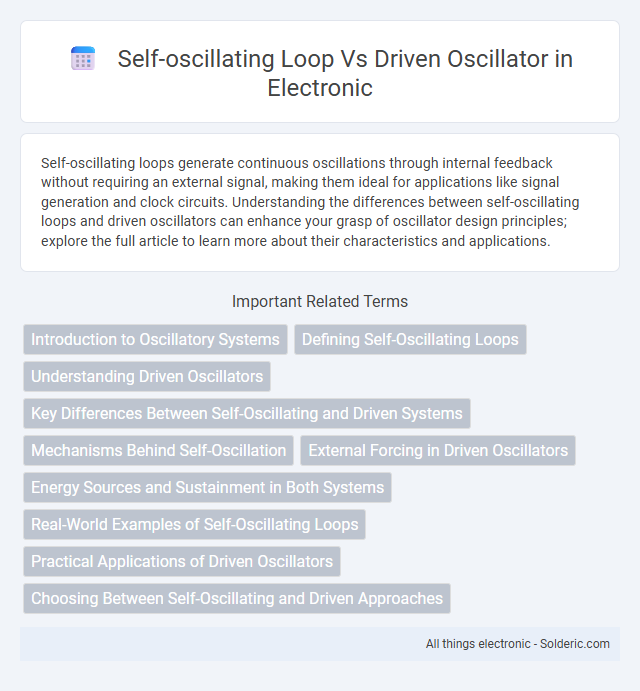Self-oscillating loops generate continuous oscillations through internal feedback without requiring an external signal, making them ideal for applications like signal generation and clock circuits. Understanding the differences between self-oscillating loops and driven oscillators can enhance your grasp of oscillator design principles; explore the full article to learn more about their characteristics and applications.
Comparison Table
| Feature | Self-Oscillating Loop | Driven Oscillator |
|---|---|---|
| Operation Principle | Generates oscillations using feedback without external input | Oscillations created by external periodic driving signal |
| Energy Source | Internal feedback loop supplies energy | External driving force provides energy |
| Frequency Stability | Stable frequency determined by loop components | Frequency depends on driving signal |
| Applications | Signal generators, oscillators in circuits | Resonance studies, frequency locking, forced vibrations |
| Control Complexity | Requires careful feedback design | Control via driving signal parameters |
| Examples | LC oscillator, Hartley oscillator, Colpitts oscillator | Driven pendulum, driven RLC circuit |
Introduction to Oscillatory Systems
Oscillatory systems consist of components that generate periodic signals through energy exchange mechanisms. A self-oscillating loop produces sustained oscillations by feeding a portion of its output signal back into its input to maintain continuous energy supply without external periodic input. In contrast, a driven oscillator relies on an external periodic driving force to sustain its oscillations, with its frequency primarily determined by this external source.
Defining Self-Oscillating Loops
Self-oscillating loops generate sustained periodic signals without an external input by using feedback to maintain oscillations. These loops rely on the system's internal energy and inherent nonlinearities to stabilize amplitude and frequency. Your design can benefit from self-oscillating loops when continuous, stable oscillations are needed without an external driving force.
Understanding Driven Oscillators
Driven oscillators rely on an external periodic input signal to sustain their oscillations, making their frequency and amplitude dependent on this external source. In contrast to self-oscillating loops, which generate oscillations through internal feedback without an external drive, driven oscillators require continuous energy input to maintain steady-state oscillation. Key examples include forced mechanical vibrations and electronic circuits like the driven RLC resonator, where the response frequency matches or locks to the driving frequency.
Key Differences Between Self-Oscillating and Driven Systems
Self-oscillating loops generate continuous oscillations autonomously using feedback to maintain a stable frequency without external input, whereas driven oscillators rely on an external periodic force to sustain motion. Key differences include energy source dependency, with self-oscillating systems extracting energy internally and driven oscillators requiring external energy input. Your choice depends on application needs for stability, control, and system design complexity.
Mechanisms Behind Self-Oscillation
Self-oscillating loops rely on internal feedback mechanisms that amplify energy within the system, causing sustained oscillations without external periodic input. These systems convert a constant energy source into periodic motion by exploiting nonlinear components or regenerative feedback, maintaining oscillation amplitude automatically. Your understanding of self-oscillation is crucial for designing circuits such as relaxation oscillators, where the mechanism ensures stable frequency generation without requiring an external driving signal.
External Forcing in Driven Oscillators
Driven oscillators rely on external forcing, meaning they require an outside periodic input to maintain their oscillations at a fixed frequency and amplitude. This external forcing distinguishes them from self-oscillating loops, where the system sustains oscillations through internal feedback mechanisms without needing an external source. Understanding this difference is crucial when designing circuits for applications where precise frequency control via external signals is necessary.
Energy Sources and Sustainment in Both Systems
Self-oscillating loops generate sustained oscillations by converting a DC energy source into periodic signals through internal feedback mechanisms, maintaining energy within the system without external periodic input. Driven oscillators require an external time-varying energy source or input signal to sustain oscillations, relying on continuous external energy injection for operation. The key distinction lies in energy sustainment: self-oscillating loops internally stabilize their amplitude via nonlinear feedback, while driven oscillators depend on the amplitude and frequency of the external driving force.
Real-World Examples of Self-Oscillating Loops
Self-oscillating loops are essential in real-world applications such as electronic oscillator circuits, where they generate stable, continuous waveforms without external periodic input. Common examples include quartz crystal oscillators in watches and radio transmitters, where the loop sustains oscillations through feedback mechanisms. Your understanding of these loops helps in designing precise frequency sources that differ fundamentally from driven oscillators, which rely on external signals to maintain oscillations.
Practical Applications of Driven Oscillators
Driven oscillators are widely used in practical applications such as radio transmitters, signal generators, and clocks where a stable frequency output synchronized to an external source is essential. You can rely on these oscillators for precise frequency control in communication systems, sensor circuits, and electronic instrumentation. Unlike self-oscillating loops, driven oscillators maintain consistent amplitude and frequency by continuously receiving energy from an external drive signal, optimizing performance in complex electronic systems.
Choosing Between Self-Oscillating and Driven Approaches
Choosing between self-oscillating loops and driven oscillators depends on the stability requirements and application context; self-oscillating loops inherently generate oscillations without external input, ideal for frequency synthesis and clock generation. Driven oscillators rely on an external periodic signal for operation, offering better control over frequency precision and phase noise in communication systems. Evaluating trade-offs in complexity, phase noise, and frequency stability guides optimal selection for RF and signal processing applications.
Self-oscillating loop vs Driven oscillator Infographic

 solderic.com
solderic.com